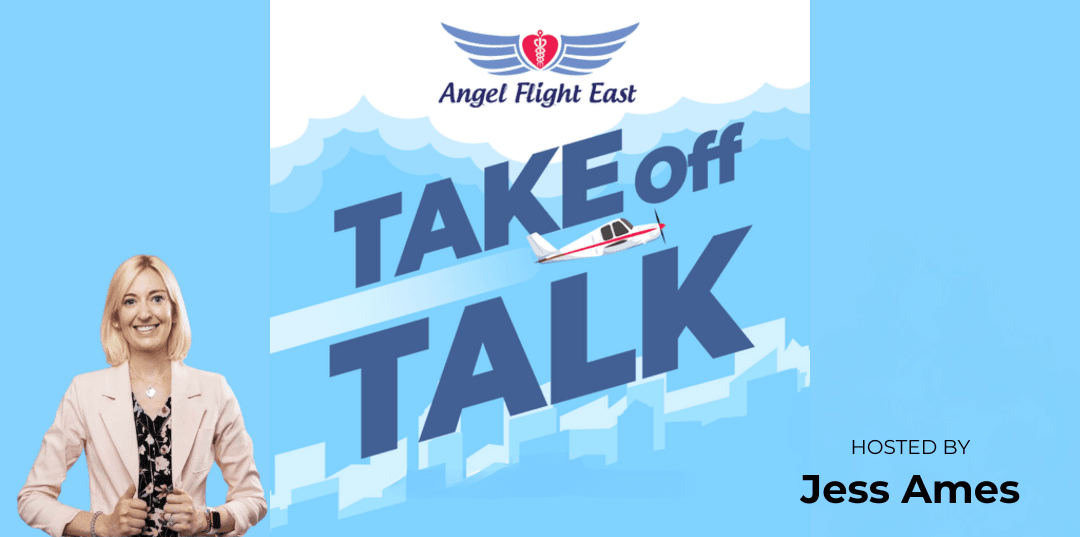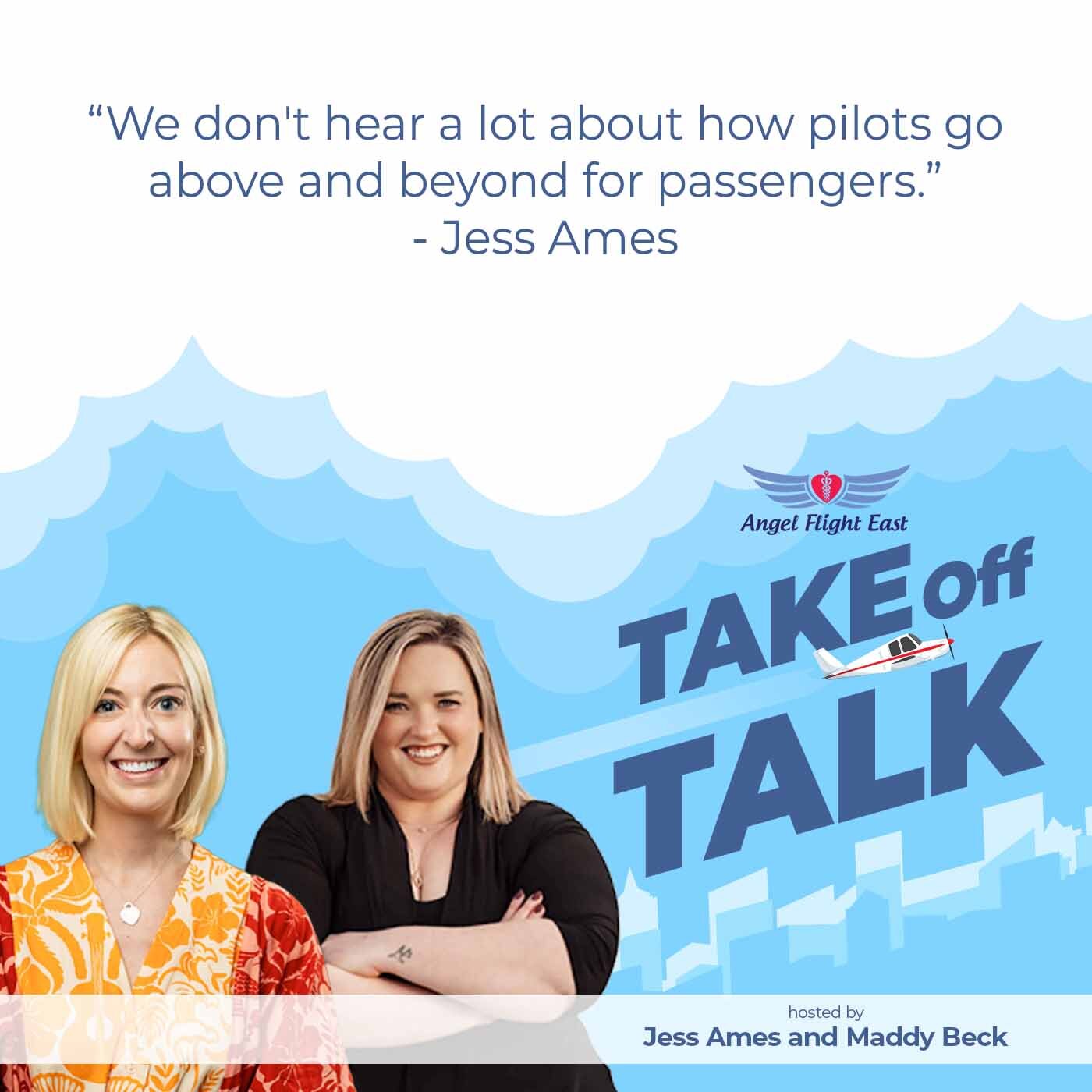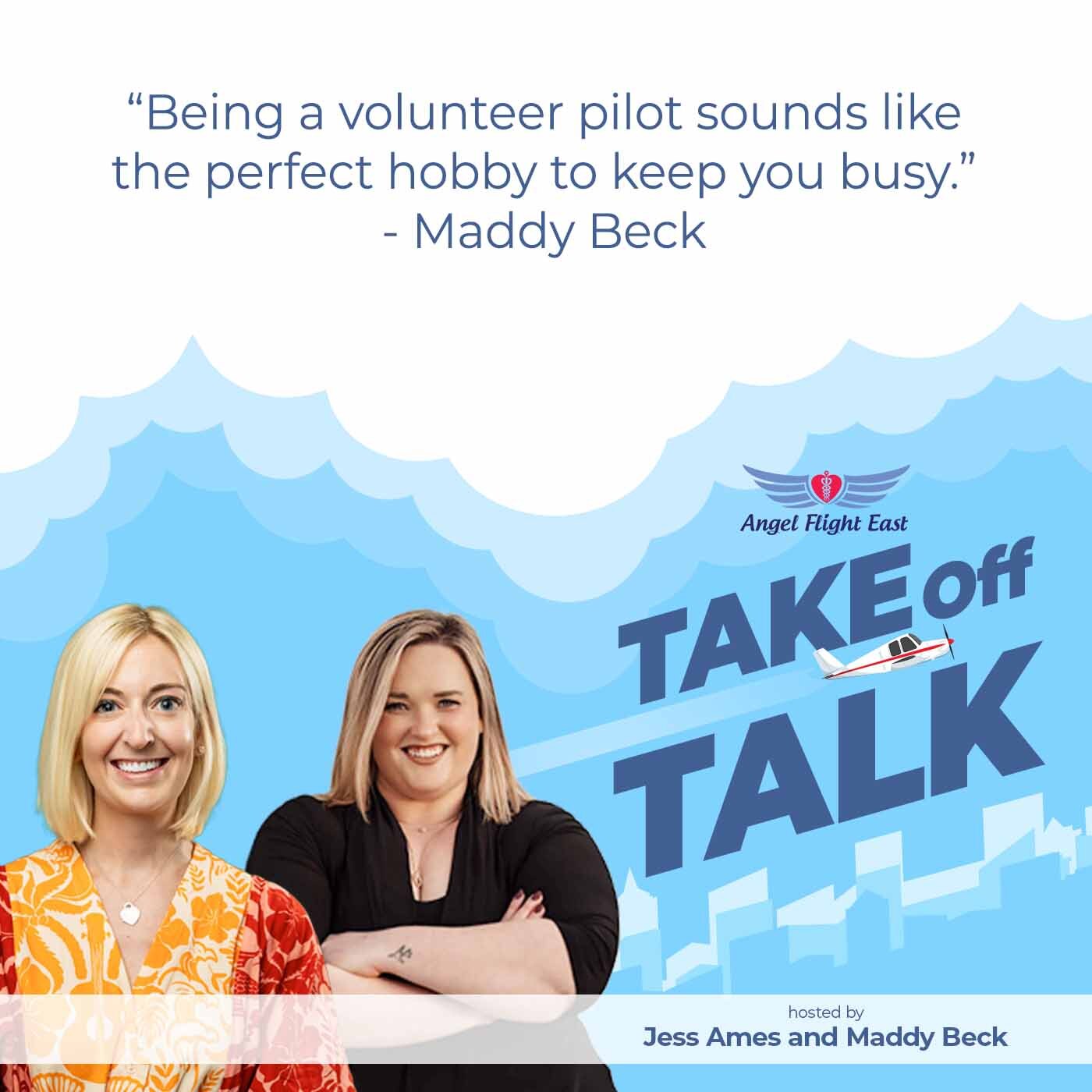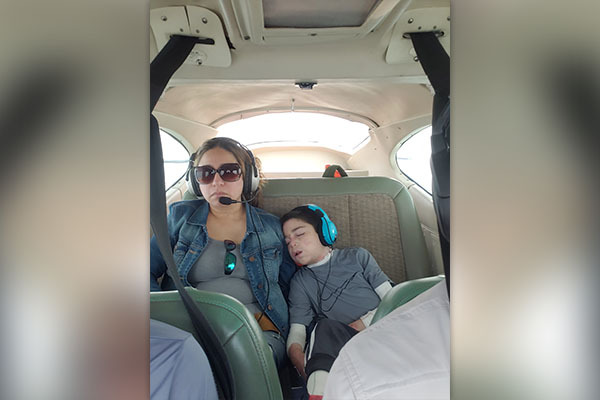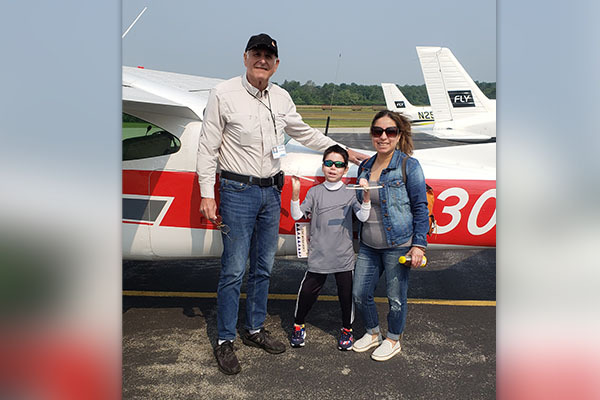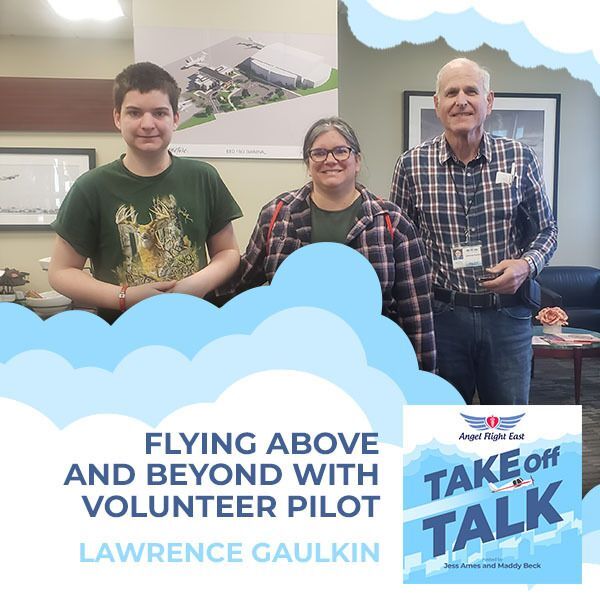
Fly with purpose and soar beyond limits, for in the sky lies the extraordinary power to transform lives and ignite hope. Join Jess Ames and Maddy Beck as they sit down with Lawrence Gaulkin, a volunteer pilot with Angel Flight East. Lawrence shares his personal experiences and motivations for becoming a pilot, and how his retirement opened up a whole new world of meaningful service. As the discussion unfolds, Lawrence shares his initial apprehensions about carrying strangers and the transformative moment that ignited his passion for public benefit flying. From heartwarming stories of flying a 14-year-old boy battling a serious illness to exploring the unique challenges and rewards of non-commercial flying, Lawrence sheds light on the incredible impact volunteer pilots can have on the lives of their passengers. Discover the joy of providing comfort, support, and even a sense of adventure to those in need. Tune in now!
---
Watch the episode here
Listen to the podcast here
Frequent flyers, welcome back with another episode. You're here with me, Maddy.
Me, Jess.
Now, we have pilot Lawrence.
Good afternoon.
How long have you been flying with Angel Flight East?
I actually started flying with Angel Flight East for five months.
Welcome to the club. A newbie.
I signed up in 2022 but it took a while to get over my initial fear of carrying people that I didn't know.
That's the second conversation we've had about a stranger to stranger interactions with public benefit flying.
Once I started, I love it. It's great.
That's awesome. How did you find Angel Flight?
I'm a member of a flying club and one of our members gave a talk about it. I said, “I'm flying all over the countryside doing nothing. I might as well make it worth my while and visit new places.”
Which flying club is it?
Congressional Flying Club out of Gaithersburg, Maryland.
Who gave the talk on it? We have to know who's talking about us.
That was a fellow by the name of Johannes Van Damm.
I know him.
Why do you volunteer? What part of his talk sparked an interest in you?
I worked as a family doctor for 40 years and I retired a few years back. I missed the interaction with people. With COVID and everything, I was pretty much isolated. I moved up here from Florida a few years back. When I started flying, I found out that most of the airports I was visiting were abandoned. People were not coming out. The restaurants, a lot of them were not open. I was flying to the same places over and over again. When Johannes started talking about taking people who needed to be somewhere and making connections, I got interested.
Do you have a favorite flight that you've done with us?
Yes. The last flight I took was confusing because the signup was all messed up. This was a 14-year-old kid with a very serious disease that caused horrible malnutrition. He weighed 47 pounds. Somebody looked at that and said, “Fourteen is wrong. It must be 4.” They made it a 4-year-old kid, and for some reason, the mother went from 145 to 200. I'm 200 pounds myself. I'm sitting there doing weight and balance all over the place, trying to figure out how to get this kid around.
We got it all straightened out. The boy was fantastic. I emailed him and I said, “Is there anything you want for the flight?” I usually try to provide some snacks or something. He said, “Yes, FUNYUNS.” That's what he wanted, FUNYUNS or Doritos. He asked, “Are there any LEGOs on the flight?” I said, “I can get you some LEGOs, but you can't open the package in the airplane.”
I want to be a passenger on your flight then.
I've been on a lot of airplane flights all over the world, and boredom is easy enough. It's worse when you're in a small airplane. There are lots of things going on that large airplanes don't have. On the first Angel Flight I took, the crosswinds were near maximum and gusty. I warned the people I was flying that it was going to be rough. After the flight, which turned out, once we got to altitude, it was very calm. It was really nice but the landings and takeoffs were horrible. I apologized and they said, “We've had worse.” I don’t know if they said that to make me feel better, but they were reasonably happy with it. I volunteered to take them again. They're going back in September 2023. I didn't hear any objections. This young kid, we were flying from Massachusetts to North Carolina.
"Boredom is easy enough when piloting a plane. It's worse when you're in a small airplane. There are lots of things going on that large airplanes don't have."
There was a fuel stop in Richmond on the way. The Canadian fires were going on and were really nasty. It was a total instrument flight from takeoff to landing the whole way. They had nothing to see but clouds. We landed in Richmond. I asked the family if they wanted to get something to eat because Richmond airport has a fairly decent cafeteria. They said, “Yes.” I said, “Great.” I had planned the flight to take two and a half hours from Massachusetts to Richmond and about two hours to get to North Carolina.
As it turned out, the child had such a bad disease. He took two and a half hours to eat a small amount of food. I took it. I had nowhere else to go. As we got back down to Charlotte, the weather had cleared a bit and I circled the motor speedway in Charlotte. He got a kick out of that. He was such a wonderful little boy, and I felt so bad for him and his family. The child has a really serious disease. He probably won't live a lot longer, but he was upbeat, hopeful, and happy to do anything.
That's amazing. I feel like we don't hear a lot about how the pilots go above and beyond for passengers. You telling that story makes all the more impact on what our volunteer pilots do for our patients.
As a doctor and a professor of medicine, I get them at the end of the line. They've made the trip, get into my office, my clinic, or whatever, I'm all business. “What's wrong with you? What can we do for you? Tick-tock, give me the story and let's get on with it.” It's very rare nowadays to be able to have somebody to do something more than, “Here you go. Take it and leave it.” At this point, I try to look for something extra for what I can do for the people that are in my airplane because they're putting a lot of faith in my 1979 177.
Although interestingly, the one I flew back from Massachusetts to Ohio, I'm flying them from Pennsylvania to Massachusetts in September because somebody else picked up the first part of the flight. I usually don't like to do half a flight. The guy taking them from Ohio to Pennsylvania is flying a warrior so they're going to squeeze this kid into a smaller airplane than mine. They'll be very happy to get in mine.
As a matter of fact, my airplane has bad upholstery, and after the second flight, I bought new seat cushions for both me and the passengers. My flights now from start to finish are taking between 13 and 14 hours. It's a long time to be sitting in that seat. I have to fly from my home base to wherever I'm picking them up, which is a couple of hours, and then it's a couple of hours for the first leg and 2 or 3 hours for the second leg. I'm flying somebody from Rutgers, New Jersey to Michigan. The flight back is going to be a six-hour ordeal.
That's a long day.
Yes, but luckily, I have an autopilot to do a lot of the work. For the most part, it's watching the gauges and making sure I've got a place to land in an emergency. I have pictures from my flights that I sent you where the passenger was asleep. That's perfectly fine with me. If I can be boring enough that the passengers can sleep on my airplane, I'm very happy with that.
That's always a sign of a good pilot. Are we the only organization that's keeping you busy in retirement?
So far. Money is somewhat of an obstacle. Thirteen hours in the airplane cost me about $1,500 and right now, I'm doing one a month. In a couple of years, my retirement kicks in, and I've got to start spending a lot more money. I might pick up something else. Being from Florida, Turtles Fly is calling me. I don't know if the other guys in my flying would appreciate what's left over after I fly a Turtle for 800 miles.
Is that Turtles Fly Too?
Yes.
We love them.
I want one of their T-shirts.
What made you want to become a pilot in the first place?
I always loved airplanes. I used to hang out at airports and watch. My father did not like little airplanes and he would not let me get training. When I was growing up, controlled airspace was a whole different ballgame. Navigation was very primitive, non-directional beacons, which I learned when I was starting out. They're totally gone now. The airplanes that I fly don't even have receivers for me. I had to put that aside for my medical education, getting into practice, having kids, and sending them off to college. At one point, my son got interested in Civil Air Patrol.
I joined Civil Air Patrol as a medical officer and they needed pilots. I talked to a couple of the pilots who were working with civil air patrol and I got training. I got my certification. I got my instrument rating. I started flying all over the countryside. My wife said she wasn't flying in any of those damn well airplanes. I put that on hold for a few years. When I moved up to Maryland from Florida after my wife passed away, I needed something to do, and flying was a good idea. I started back in.
It sounds like the perfect hobby to keep you busy. If you could say anything to a volunteer pilot that's tuning in or even somebody who's not a volunteer pilot yet and is thinking about becoming one, what would you say?
Don't be afraid of it. When I was teaching in Civil Air Patrol, we get kids who don't want to take the tests. They don't want to promote it because they're afraid of getting yelled at. I train the officer staff. I was a squadron commander. I take the officer staff aside, and I say, “We have to impress on the younger kids because they're 12, 13, and 14 years old. We want them to win. We want them to succeed.” The people that you're flying for Angel Flights are not doing it because they want to save money.
They're not doing it for convenience. They're doing it because they need to be somewhere to get the help they need, and they want to go. They're willing to put up with a lot to get there. A pilot who says, “My airplane is old. I'm rusty,” don't be that way. You get used to filing flight plans. You get used to following air traffic control. You meet the most wonderful people who want to be there. It's the most rewarding experience anyone can have, short of winning the lottery.
Even what you said about passengers will jump through hoops to get to where they need to go, even if some of our flights could be 2 to 3 legs, we always tell them it's going to be a very long day of travel. We want to make sure it's the best moment of transportation for them. They're always so willing to do whatever it takes to get that treatment that they need. A lot of times, this could be their last option or hope.
Flying commercial, you take off, climb to 30,000 feet, and see nothing. There's a green splotch down below if the clouds don't get in the way. That's it. In my airplane at 7,000 or 8,000 feet, I'm flying over Western Massachusetts. I point out the Hudson River. I show them the sites. They get to see things that they wouldn't see on a commercial flight. A lot of people are very surprised at what they see.
I bet they would much rather fly private or general aviation airplanes now than commercial ones. Nobody likes to fly commercials. It takes too long.
The flight I took, the person from Central Massachusetts to North Carolina, if they had had to go to Boston Logan from where were, which was the closest commercial airport, and fly to a hub in Charlotte to get to their house, after all the TSA and the boarding weight and everything, I beat them by half an hour. It's not necessarily the slow way.
Let alone it's also the safer way. Especially you, as a physician, know, they're exposed to so much less by flying directly with you instead of flying with every Tom, Joe, and Jim who's in Boston Logan Airport.
Not to mention the crowds at the airports, people who are flying sick because they want to get there. They've already got their tickets and they're not going to get a refund. It's not something I stress to the passengers because they don't need to know all that stuff. All they know is they've got a way to get home. I'm going to make it as nice as I can for them. They're very appreciative of anything I do.
That leads me to another question, and this is off the sheet, I’m so sorry. What would you say to any medical professionals tuning in about bringing a patient to Angel Flight if they're apprehensive, they have questions, or anything like that?
We already know what's up. You give us a diagnosis and we can give you chapter and verse on what the problem is, how it's being treated, and what to expect. There are no surprises to being a medical professional. If I'm flying along and the passengers tell me, “I've got a problem. I need to be down.” The nice thing is I don't have to look very far to find a place to land. On a commercial flight, if they notify the stewardess that they have a problem, first of all, there's no medical kit on airplanes.
Commercial jets do not have the supplies necessary to support someone until they get on the ground. They have to get air traffic control to find a large airport where they can land and then arrange for transportation somewhere. I can get a small towered airport within 20 miles or 30 miles of wherever I'm flying. I can get in touch with the tower. I can say I have a medical emergency and I'm going to need an ambulance on the field. I land right in front of the ambulance. There's no big deal. I would say to medical professionals, if you had a choice between flying commercial and flying private, I would tell sick people to go private.
"If sick people had a choice between flying commercial and flying private, go private."
That's a great point. I didn't even think about that part.
Where would you say your favorite place is to fly to? How do you choose?
We won't blame you if you say Florida.
I flew to Florida for ten years and it's a nightmare. Some of the air traffic controllers are very nice. If you're flying into Miami's airspace, be ready to get yelled at. They don't care. My favorite place to fly right now is Westchester, New York. I fly up the Hudson River at 1,000 feet. I get all these sites. On the way back, I get to circle the Statue of Liberty.
We are definitely going on that flight next time.
Come on down. I'll take you and show you all the sites. I fly past Central Park, right near Yankee Stadium, and over to the Intrepid Carrier Museum. It's low enough that you see. I'm about 200 or 300 feet below the tops of the buildings. The biggest secret is nobody knows about it. It's actually a visual flight path. You don't even have to file a flight plan. You have to get to the right altitude and call out your checkpoints as you go along the Hudson. I fly from the Verrazzano-Narrows Bridge up to the Tappan Zee Bridge north of the city. I turn right and get my okay to get into Westchester and make a landing. Call an Uber. I can go downtown and party for whatever I want.
That's so fun. Not party too hard though because it's eight hours bottle of throttle.
No. From Gaithersburg, it's a two-hour flight to Westchester. My partner and I usually take a bus or a train to New York for three and a half hours, and then you've got to take the subway and all. I said, “Why don't we fly to Westchester and take an Uber to the hotel?” I go to the opera up there and a few times a year, we go to jazz at Lincoln Center and we get a room on Central Park South. I said, “Why are we fooling around with all this nonsense three and a half hours of traveling?” At one point, there was a traffic accident on I-95 and she got hung up on the bus for 4 or 5 hours. I said, “Fly up to Westchester for two hours. It's an hour’s drive down to the city and we're there for lunch.”
That is the dream.
the biggest problem I find with pilots is they don't realize their potential. They fly to the same places all the time. They don't vary it. They don't look for adventures and changes. They practice but when it comes down to it, they're not using their skills for anything productive. I see these guys in $1 million airplanes and they're buzzing from their home here to their grandpa's house or Aunt Sally's. They're not saying, “Why don't we fly out to the Smokies and spend the week in a chalet up there?”
That's where I want to be.
It's a great place. I spent a week in the Smokies and they've got some nice houses for rent cheap. You live up on the side of the mountain and you're looking out over the park.
Maddy is planning our next vacation now. She doesn't know it yet.
There's a chateau at the top of Mount Le Conte 6,495 feet. You have to hike up. It's an eight-hour hike, but you get dinner and sleep in the chalet for a couple of nights if you want. They've got a great buffet breakfast and then you hike down. On Mondays, they have a llama train that hikes up to take supplies. That's how they get their supplies up there.
A Llama train? I love that. I didn't even know that was a term. I've got to find some other way to use that in my life.
Look it up.
I have a lot of googling to do. What is the final thing that you would leave our audience with?
I have been in a lot of service industries. I've been in medicine and Civil Air Patrol. I've been in the National Association for Search and Rescue. I have done a lot of service and this is probably the most rewarding use of my time that I have found.
That is amazing.
Thank you so much for all you do for both us and our passengers.
Trust me. It's my pleasure.
We appreciate you and thank you so much for joining us. We are looking forward to sharing your story with all of our audience.
You're very welcome.
---
I was going to look into us doing that vacation in the Smokies until he said that we have to do an eight-hour hike with a llama train.
That's why I want to go. I want to see this llama train.
What if I find us a petting zoo somewhere near an Airbnb that we can not have to hike eight hours to?
That's not the same. I want to see the llama train. I want to do the eight-hour hike and maybe do a 5K while we're there.
Do you realize how many bugs that are going to be? It's in the mountains.
Yes, but that's why they make bug spray.
What if they don't have electricity? What if the electricity goes out?
What if we have to camp?
I'm not pooping in a hole.
We shouldn't do these in the afternoon anymore. I feel like we're in our prime in the morning.
These are getting a little sleepy hahas. I am so sorry to the audience that gets us at this point. We are still so grateful that you guys are sticking it out with us. I don't know. It's one of those things where it's a wreck on the side of the highway and you can't look away because you know the car is on fire.
Speak for yourself.
You don't think this car is on fire?
It's a whole production like Andy said. I looked now.
I'm not even going to respond. I can't think of a response that I could probably say without them cutting it out anyway.
We really appreciate you tuning in and subscribing. We have way more subscribers than we thought we ever would. Somebody out there thinks we're funny besides our moms and ourselves. We will see you next episode.
See you then.
Bye.
Important Links

